| View previous topic :: View next topic |
| Author |
Message |
propellor


Joined: 29 Apr 2010
Posts: 205
Location: Amsterdam
|
 Posted: Thu Apr 29, 2010 8:56 pm Post subject: CZJ pentagon six lenses on a Canon 5d MKII Posted: Thu Apr 29, 2010 8:56 pm Post subject: CZJ pentagon six lenses on a Canon 5d MKII |
 |
|
propellor wrote:
Hi everyone,
My name is bart from Amsterdam, The Netherlands. I am thinking of using Zeiss Pentacon Six "Zebra's" on my Canon 5d MKII.
I am unclear about the following: I have read that the focal lenght of the Zebra's should be halved when used on a full size sensor. Others wrote that this is not true and that a 50mm Zebra acts like a 50mm on the 5D.
Can someone please enlighten me?
If a 50 acts like a 50, I would need wider lenses to make up my range. Would the M42 Zebra's be an option to get the same "feel and character" as with the P6 lenses and which ones would fit on the 5D?
The camera will only be used for filming in HD.
Thanks in advance.
Bart. |
|
| Back to top |
|
 |
sichko


Joined: 20 Jun 2008
Posts: 2475
Location: South West UK
|
 Posted: Thu Apr 29, 2010 9:36 pm Post subject: Posted: Thu Apr 29, 2010 9:36 pm Post subject: |
 |
|
sichko wrote:
The focal length of a lens is defined even in the absence of a camera. So a 50 mm P6 lens does not change its focal length if you use an adapter to use it with a Canon.
_________________
John |
|
| Back to top |
|
 |
no-X


Joined: 19 Jul 2008
Posts: 2495
Location: Budejky, Czech Republic
|
 Posted: Thu Apr 29, 2010 10:17 pm Post subject: Posted: Thu Apr 29, 2010 10:17 pm Post subject: |
 |
|
no-X wrote:
Exactly. Flektogon 50/4 P6 will have the same angle of view as any other 50mm lens.
The key difference of medium format lenses is that they draw larger image circle to cover the bigger area. But they also collect light from a wider are. So if you use it on 36x24 sensor, the additional light, which is collected to cover the larger field (and which makes the 50mm lens wide on P6 body), is discarded and that's why it perform just like any other 50mm lens
I tried to draw a scheme... hope it helps 

_________________
(almost) complete list of Helios lenses |
|
| Back to top |
|
 |
propellor


Joined: 29 Apr 2010
Posts: 205
Location: Amsterdam
|
 Posted: Fri Apr 30, 2010 7:25 am Post subject: Posted: Fri Apr 30, 2010 7:25 am Post subject: |
 |
|
propellor wrote:
Thanks very much for the info. The drawing is very clear. So the main advantage would be that you use the best part of the lens ie, "the sweet spot".
Would the 20 and 35 mm lenses with th m42 mount be an option to complete the range and get the same look and feel as the P6 Zebra's ?
thanks guys. |
|
| Back to top |
|
 |
peterqd


Joined: 28 Feb 2007
Posts: 7448
Location: near High Wycombe, UK
Expire: 2014-01-04
|
 Posted: Fri Apr 30, 2010 8:52 am Post subject: Posted: Fri Apr 30, 2010 8:52 am Post subject: |
 |
|
peterqd wrote:
no-x, thankyou for your useful diagram! Do you think it would help explain a bit better if you showed the larger back-focus distance for the P6 lens? This is the reason it gives a larger image, I think. The viewing angle for both lenses should be the same. Please tell me if I'm wrong! 
_________________
Peter - Moderator
Last edited by peterqd on Fri Apr 30, 2010 3:38 pm; edited 1 time in total |
|
| Back to top |
|
 |
peterqd


Joined: 28 Feb 2007
Posts: 7448
Location: near High Wycombe, UK
Expire: 2014-01-04
|
 Posted: Fri Apr 30, 2010 9:14 am Post subject: Posted: Fri Apr 30, 2010 9:14 am Post subject: |
 |
|
peterqd wrote:
Hello Bart and welcome to our forum!
I can't be as helpful to you on this topic as I'd like to be. Is it your wish to make a collection of "Zebra" lenses or a set of lenses with similar optical qualities?
Someone else will know much more about P6 lenses than I do. The M42 CZJ Zebras went out of fashion in the mid-60s, before multi-coating was invented. The old Zebra f4/20mm and 2.8/35mm Flektogon lenses were redesigned and mostly improved for the later black versions but I think, except for the coatings, the 50mm and 80mm Pancolars and the 135mm Sonnar were the same optics with just a cosmetic change to the barrel.
_________________
Peter - Moderator |
|
| Back to top |
|
 |
sichko


Joined: 20 Jun 2008
Posts: 2475
Location: South West UK
|
 Posted: Fri Apr 30, 2010 9:29 am Post subject: Posted: Fri Apr 30, 2010 9:29 am Post subject: |
 |
|
sichko wrote:
| peterqd wrote: |
no-x, thankyou for your useful diagram! Do you think it would help explain a bit better if you showed the larger back-focus distance for the P6 lens? This is the reason it gives a larger image, I think. The viewing angle for both lenses should be the same. Please tell me if I'm wrong!  |
If you look at a P6-Canon adapter you will see that it is quite long. This is in order to place the canon sensor at the same distance from the lens as the film plane would be in a P6 camera. The viewing angle depends upon the focal length and the film/sensor size. So a 50 mm lens is classed as normal on the 24 x 36 mm format, a short tele on a APS-C crop camera and a wide on P6.
_________________
John |
|
| Back to top |
|
 |
peterqd


Joined: 28 Feb 2007
Posts: 7448
Location: near High Wycombe, UK
Expire: 2014-01-04
|
 Posted: Fri Apr 30, 2010 3:38 pm Post subject: Posted: Fri Apr 30, 2010 3:38 pm Post subject: |
 |
|
peterqd wrote:
| sichko wrote: |
| The viewing angle depends upon the focal length and the film/sensor size. |
Thanks John, I did understand all that but "viewing angle" was the wrong term possibly. I meant that all 50mm lenses will have a similar field of view and cast the same image content onto a white wall. The size of the film frame or sensor has no impact on this at all. When the image is in focus on the wall, the image circle with a P6 lens is larger than a 35mm lens because the back-focus distance is larger.
I'm not saying the diagram is wrong, What I mean is that it would be easier to understand (for me anyway!) if it showed the different back-focus distances for the two lens types.
_________________
Peter - Moderator |
|
| Back to top |
|
 |
no-X


Joined: 19 Jul 2008
Posts: 2495
Location: Budejky, Czech Republic
|
 Posted: Fri Apr 30, 2010 5:49 pm Post subject: Posted: Fri Apr 30, 2010 5:49 pm Post subject: |
 |
|
no-X wrote:
The distance between the lens and sensor (film) is same for all cameras. Moving the lens far from the sensor would involve it in the same way as adding an macro extension tube (= it will allow close focusing only).
_________________
(almost) complete list of Helios lenses |
|
| Back to top |
|
 |
peterqd


Joined: 28 Feb 2007
Posts: 7448
Location: near High Wycombe, UK
Expire: 2014-01-04
|
 Posted: Fri Apr 30, 2010 6:08 pm Post subject: Posted: Fri Apr 30, 2010 6:08 pm Post subject: |
 |
|
peterqd wrote:
| no-X wrote: |
| The distance between the lens and sensor (film) is same for all cameras. |
This just isn't correct, I'm sorry to disagree with you. Pentacon 6 back focus is 74.1mm, M42 is 45.46mm and Canon EOS is 44mm, but I'm sure you know this already! What are you trying to tell me?
_________________
Peter - Moderator |
|
| Back to top |
|
 |
sichko


Joined: 20 Jun 2008
Posts: 2475
Location: South West UK
|
 Posted: Fri Apr 30, 2010 7:12 pm Post subject: Posted: Fri Apr 30, 2010 7:12 pm Post subject: |
 |
|
sichko wrote:
| peterqd wrote: |
| no-X wrote: |
| The distance between the lens and sensor (film) is same for all cameras. |
This just isn't correct, I'm sorry to disagree with you. Pentacon 6 back focus is 74.1mm, M42 is 45.46mm and Canon EOS is 44mm, but I'm sure you know this already! What are you trying to tell me? |
Peter, I don't think that these these numbers are important - except in terms of the mechanical implementation of the lens. They are simply Register lengths - the distance between the film/sensor plane and the front of the camera mounting flange. If you chop 20 mm of the front of a P6 camera and add 20 mm to the back of a P6 lens the Register becomes 54.1 mm but optically nothing changes. In practice the mechanical implementation might be difficult.
| no-X wrote: |
| The distance between the lens and sensor (film) is same for all cameras. |
I agree. However perhaps I can expand on the statement. The distance referred to is that between the optical centre (See note) of the lens and the film/sensor plane. The OP is talking about a 50 mm P6 Zebra. Presumably this is the 50/4 Flektogon. This is a retro focus design just like the 35/2.4 which is familiar on 35 mm camera systems. The optical centre lies outside the optical cell and behind it. However if the lens is focused at infinity the optical centre is 50 mm in front of the film/sensor plane. As no-X has indicated this is true whether the lens is mounted on a P6 camera or a Canon with use of an adapter.
The confusion arises (I think) when we compare the P6 Flektogon with a non-retrofocus 50 mm lens (one of the Canon primes say). Here the optical centre sits inside the optical assembly. The lens must be mounted much closer to the sensor/film in order that the optical centre of the lens can be at 50 mm for infinity focus. Thus a much shorter Register is used.
Note I have used the term optical centre. It may be that this is incorrect. I have seen it used by a respected (by me) source. However I have also seen reference to the rear focal plane (which I think might be better) and references to nodal points of various sorts. Perhaps an optics expert can help.
_________________
John |
|
| Back to top |
|
 |
peterqd


Joined: 28 Feb 2007
Posts: 7448
Location: near High Wycombe, UK
Expire: 2014-01-04
|
 Posted: Fri Apr 30, 2010 10:04 pm Post subject: Posted: Fri Apr 30, 2010 10:04 pm Post subject: |
 |
|
peterqd wrote:
This is all fine but I don't think it has much to do with the comment I made about the diagram. The fact is, if you project an image through a P6 lens onto a white surface, the back of the lens, the mount surface, has to be 74.1mm from the surface for the image to be in focus, and for an M42 lens the distance is 45.46mm, so the image will be smaller. I'm sorry I mentioned it, please let's drop it now.
_________________
Peter - Moderator |
|
| Back to top |
|
 |
propellor


Joined: 29 Apr 2010
Posts: 205
Location: Amsterdam
|
 Posted: Sat May 01, 2010 7:59 am Post subject: Posted: Sat May 01, 2010 7:59 am Post subject: |
 |
|
propellor wrote:
| Subfanatic wrote: |
| propellor wrote: |
| So the main advantage would be that you use the best part of the lens ie, "the sweet spot". |
Yes. And you have the ability to use tilt/shift adapter too, if you need selective focus or perspective correction.
| propellor wrote: |
| Would the 20 and 35 mm lenses with th m42 mount be an option to complete the range and get the same look and feel as the P6 Zebra's ? |
Absolutely. Most 35mm Zeiss lenses are of a much higher quality than medium format ones, and that special "punch" is there with zebra or any other design variant. "Zebra" is simply one of the designs which were popular through history, it's not some special type which differs from other Zeiss lenses. Zeiss Flektogon 20mm (f/2.8 or f/4) and 35mm f/2.4 are fantastic gems, I'm sure you will be pleased  |
That sounds good.
From reading the other posts, I think I understand the technical part.
My interest in these lenses comes from this blog:
http://frankglencairn.wordpress.com/2010/04/01/vintage-zeiss-glass-on-modern-cameras/
Good quality, fast Canon lenses cost a fortune. I am a low budget film maker, so I am trying to find the best and fastest lenses possible on a tight budget. I also love the color and contrast of the old Zeiss lenses. It gives a nice 3d-ish film look.
Furthermore, the Canon and other modern lenses have a very short focus play. This is good for photography, but for filming a wider arc for focussing is much nicer. The focussing is better controlled than with Canon lenses because of the sturdy mechanics of the Zebra's with no play and a stop at the beginning and the end of focus.
Would there be any difference in using an M42 50mm compared to P6 50mm? |
|
| Back to top |
|
 |
PaulC


Joined: 23 Dec 2008
Posts: 2318
|
 Posted: Sat May 01, 2010 9:29 am Post subject: Posted: Sat May 01, 2010 9:29 am Post subject: |
 |
|
PaulC wrote:
You're not going to get the best contrast on a single-coated flek 50. You will probably get a nice result though.
The 50mm flek is quite a big lens, it hardly seems a logical choice for use on a 35mm camera when the manufacturers produce such cheap, good 50mm primes (but I probably don't understand film-makers' needs).
Also the 50mm flek is not fast at all, it is f4.
There is a lot of variability between different flektogon samples and I have some doubts about the claim that the glass of the MC versions is inferior to that of the zebras. Surely that would apply to all Zeiss lenses, and there is no evidence of it that I know.
See http://www.rickdenney.com/mother_lens_test.htm for some info about the variation in these lenses and how they compare with more expensive non-Communist glass.
_________________
View or buy my photos at:
http://shutterstock.com/g/paulcowan |
|
| Back to top |
|
 |
Frank Glencairn
Joined: 19 May 2010
Posts: 4
Location: Germany
|
 Posted: Mon Jan 10, 2011 4:57 pm Post subject: Posted: Mon Jan 10, 2011 4:57 pm Post subject: |
 |
|
Frank Glencairn wrote:
Video, especially HD-Video is an other beast.
A lot of folks try to achieve a softer, more organic film look, to take away some of the harsh oversharpness of video - the medium format Zeiss glass does exactly that.
If contrast and sharpness is what you want, this glass is not for you - but if you want a organic "analog" look with nice blooming and great roll-off in the lights, they are great.
Frank |
|
| Back to top |
|
 |
Joosep


Joined: 25 Jan 2010
Posts: 305
Location: Estonia, Tallinn
|
 Posted: Mon Jan 10, 2011 6:46 pm Post subject: Posted: Mon Jan 10, 2011 6:46 pm Post subject: |
 |
|
Joosep wrote:
The "sweet spot" story is not so simple.
Lenses have resolution power, as does P6 lenses.
Medium format lenses resolution is not very significat, BUT as resolution is measured in mm and the medium format is pretty big, then the quality output is very big.
Now you are only going to use the middle part, the resolution power will stay the same, but as the area will get smaller, so the total quality output.
So after if you would take a picture with a 6x6 and 35mm, with the same lens, then scan and resize to the same size, then 6x6 will have alot more quality, alot.
I would recommend you to go for 35mm lenses. You can get faster lenses for the same price. And because P6 lenses are for a bigger format, they are always bigger than the same focal lenght 35mm lens.
Only reason I see to use these boys, is if you want to do tilt shift or have already got a great collection of medium format lenses.
_________________
The future is analogue.
23 cameras, 25 lenses and counting. |
|
| Back to top |
|
 |
spleenone


Joined: 26 Dec 2009
Posts: 1130
Location: Slovakia
|
 Posted: Mon Jan 10, 2011 7:35 pm Post subject: Posted: Mon Jan 10, 2011 7:35 pm Post subject: |
 |
|
spleenone wrote:
I think that you never get organic film look even you use cine lenses on digital video cams. Why? Because film shooting look you can get only one way and that shoot on stock and with movie cam not with anorganic matematic calculating digitals. Although video from those digitals look pretty good speak nothing about superb 5DmkII. It makes wonders. It is true that you can achieve very nice and special character look with old optics as CZJ or old Nikkors (as I do) for example but never ... I think that you never get that lifelike and unique cine film character.
ps. try to shot on HD video camera with CZJ Sonnar 300/4 or Flektogon 50/4. I would like to see you at filmmaiking with such combination otherwise next I would like to try is at least Sonnar 180/2.8. With my Biometar 80/2.8 I felt more than comfortable even handheld.
edit: but welcome Frank
_________________
Shoot on analog mainly with
Nikkor glass
then Pentacon6TL for squares
and Fujica GL690 in case of 6x9
Carpe diem! |
|
| Back to top |
|
 |
Frank Glencairn
Joined: 19 May 2010
Posts: 4
Location: Germany
|
 Posted: Mon Jan 10, 2011 9:08 pm Post subject: Posted: Mon Jan 10, 2011 9:08 pm Post subject: |
 |
|
Frank Glencairn wrote:
| spleenone wrote: |
ps. try to shot on HD video camera with CZJ Sonnar 300/4 or Flektogon 50/4. I would like to see you at filmmaiking with such combination otherwise next I would like to try is at least Sonnar 180/2.8. With my Biometar 80/2.8 I felt more than comfortable even handheld.
|
Well, actually I do exactly that. I shot all of my short films and "Indiana Jones and the Spear of Destiny" with this combination. Looked quite nice in the theater.
http://frankglencairn.wordpress.com/vintage-zeiss-glass-on-modern-cameras/
best, Frank |
|
| Back to top |
|
 |
spleenone


Joined: 26 Dec 2009
Posts: 1130
Location: Slovakia
|
 Posted: Tue Jan 11, 2011 4:02 pm Post subject: Posted: Tue Jan 11, 2011 4:02 pm Post subject: |
 |
|
spleenone wrote:
You know what to do and you doing it right but supposedly not everything is true.
As you write...
"When you look at the numbers, they don´t seem to be real fast, but don´t be fooled.
Because of the huge diameter of those beasts they are almost twice as fast as the numbers suggest."
I must to dispute and you should know this as cinematographer that every lens marking if it is f-stops is correct. Not the front lens or not the great glass but diameter of open aperture says about maximum light which it can transmit (in pro sfere they say T-stop and that talk about true maximum light transmition). Then f2.8 on 80mm Biometar means that it is fast as 50mm glass with f1.8 which is not such superiority. Cheers
_________________
Shoot on analog mainly with
Nikkor glass
then Pentacon6TL for squares
and Fujica GL690 in case of 6x9
Carpe diem! |
|
| Back to top |
|
 |
Frank Glencairn
Joined: 19 May 2010
Posts: 4
Location: Germany
|
 Posted: Tue Jan 11, 2011 4:46 pm Post subject: Posted: Tue Jan 11, 2011 4:46 pm Post subject: |
 |
|
Frank Glencairn wrote:
Yeah, in theory - I know that.
But look at the pictures - the real world acts different.
The comparison between the 50mm/4 Flektogon
and a 50mm 1.4 Nikon (both at wide open) on my blog.
Actually even I´m not totaly sure what is going on here.
I checked it 3 times, but at wide open the f4/50mm Flektogon is almost as fast as the f1.4/50mm Nikon.
The only thing I can think of is - as you mentioned - a different T-stop because of the huge diameter.
Frank |
|
| Back to top |
|
 |
berraneck


Joined: 24 May 2009
Posts: 972
Location: prague, czech republic
|
 Posted: Wed Jan 12, 2011 1:50 am Post subject: Posted: Wed Jan 12, 2011 1:50 am Post subject: |
 |
|
berraneck wrote:
the photos on your blog lack exif - just to be sure, is the ISO sensitivity and exposure time same on both pictures?
they aren´t 100% same, the one shooted with flektogon is slightly darker (on my lcd, photoshop says the same), but not by 3stops. theory with T-stop is possible, also maybe some reflections in adapter may cause this? strange:)
_________________
equipment doesn´t count, good photographs do |
|
| Back to top |
|
 |
spleenone


Joined: 26 Dec 2009
Posts: 1130
Location: Slovakia
|
 Posted: Wed Jan 12, 2011 8:25 pm Post subject: Posted: Wed Jan 12, 2011 8:25 pm Post subject: |
 |
|
spleenone wrote:
I can try it with my Flek MC 50/4 compare lets say to Nikkor 50/2 ... I am really interested in my results
...but maybe latter. I have some exams now.
edit: yes and T-stop can differ as I know cca about one third or max half number of f-stop. Huge difference is improbable.
_________________
Shoot on analog mainly with
Nikkor glass
then Pentacon6TL for squares
and Fujica GL690 in case of 6x9
Carpe diem! |
|
| Back to top |
|
 |
Olivier


Joined: 18 Feb 2009
Posts: 5078
Location: France
Expire: 2015-08-06
|
 Posted: Wed Jan 12, 2011 10:52 pm Post subject: Posted: Wed Jan 12, 2011 10:52 pm Post subject: |
 |
|
Olivier wrote:
Looking forward your results.
I'm gonna try myself with my own Flek 4/50mm and a Canon EF 1.8/50mm.
_________________
Olivier - Moderator 
Dslr : Olympus Pen E-P2 - Fujifilm X-Pro2 - Canon 5D MkII.
SLr and MF lenses : for feedback and helping people, cameras and lenses I own : full list here http://forum.mflenses.com/viewtopic,p,1442740.html#1442740 |
|
| Back to top |
|
 |
spleenone


Joined: 26 Dec 2009
Posts: 1130
Location: Slovakia
|
 Posted: Fri Jan 14, 2011 3:26 pm Post subject: Posted: Fri Jan 14, 2011 3:26 pm Post subject: |
 |
|
spleenone wrote:
Okay... it's obvious.
Here rear element: hole is cca identical to diameter of aperture; and front which have nothing with speed of the lens. It is design lens factor. In this case 50mm Flek is wide angle compare to 50mm Nikkor which is standart lens.. .
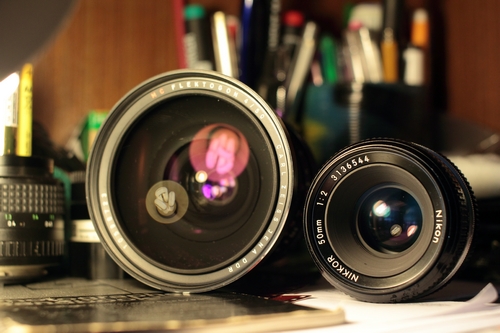
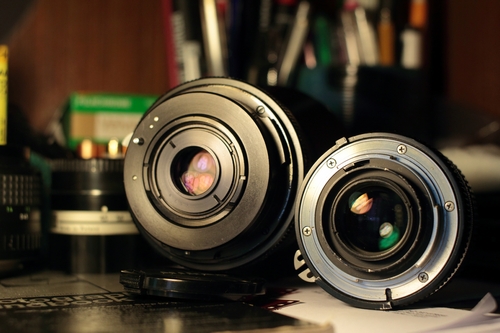
then... Flektogon mc 50/4 at f4 ... 1/80, iso 800
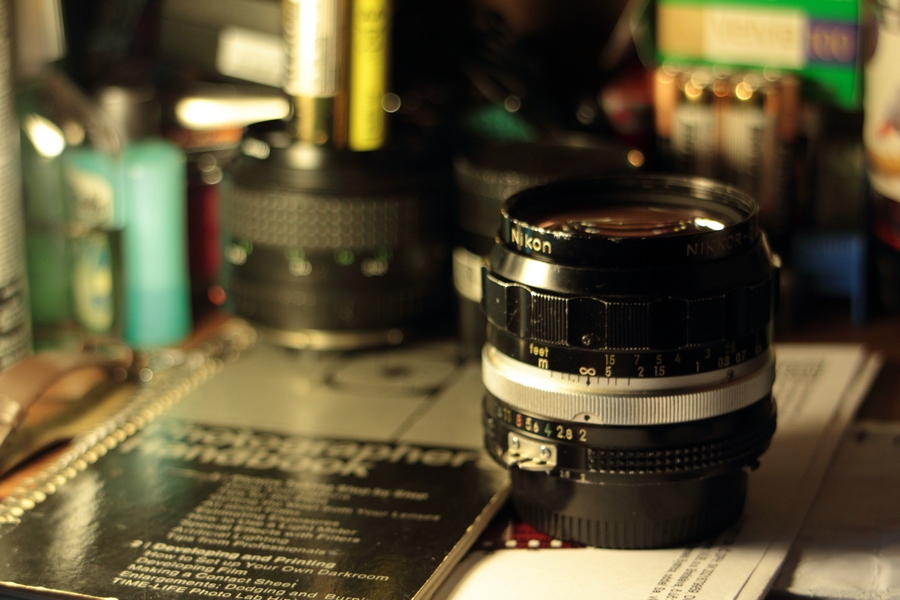
and Nikkor 50/2 Ai at f4 ...1/80, iso 800
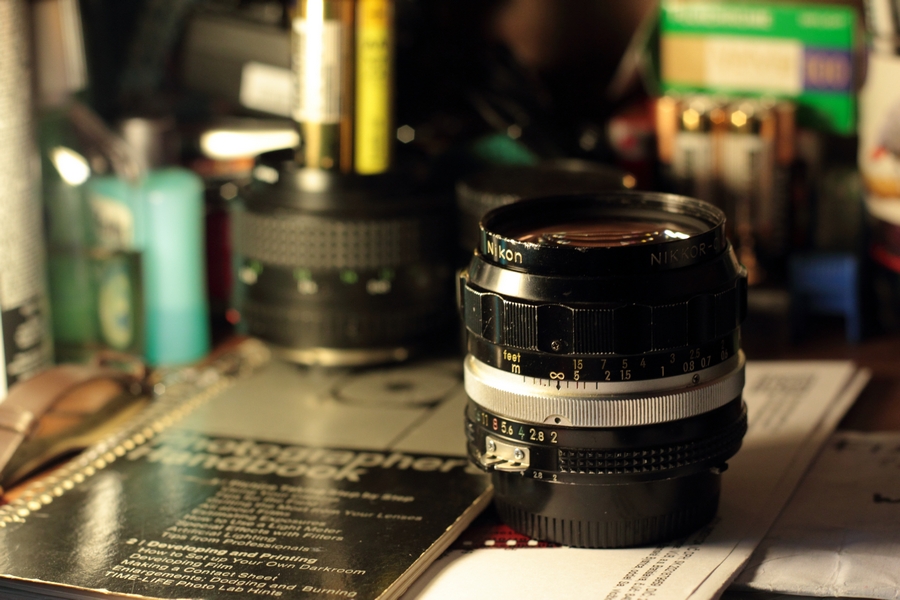
and finally Nikkor 50/2 Ai at f2 ...1/160, iso 400
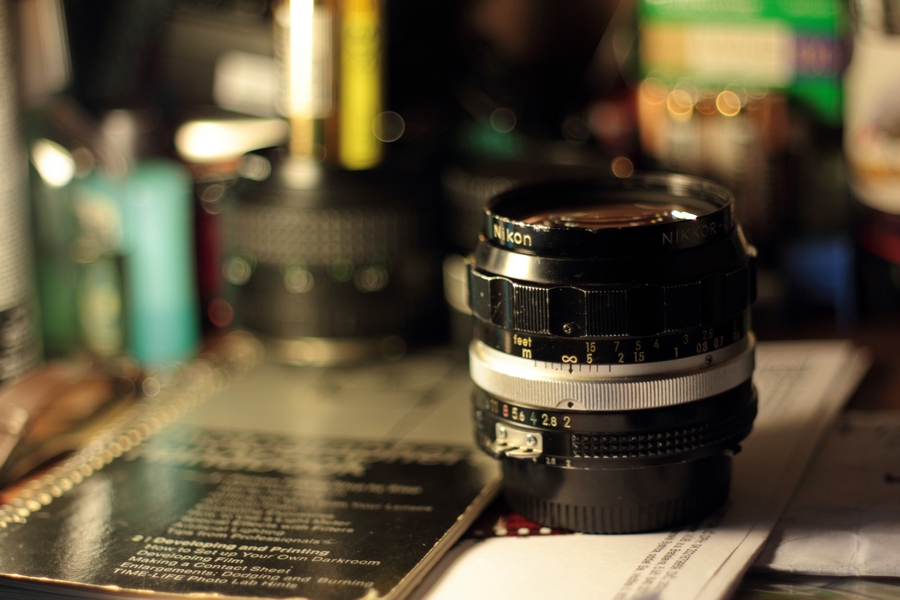
I made it good with my knowledge. Sorry for bad focusing about Flek but that lens is soft WO even at FF. On 120 format have really more and better res. But winner is clear. Nikkor =D
...in this case. Cheers.
_________________
Shoot on analog mainly with
Nikkor glass
then Pentacon6TL for squares
and Fujica GL690 in case of 6x9
Carpe diem! |
|
| Back to top |
|
 |
|
|
